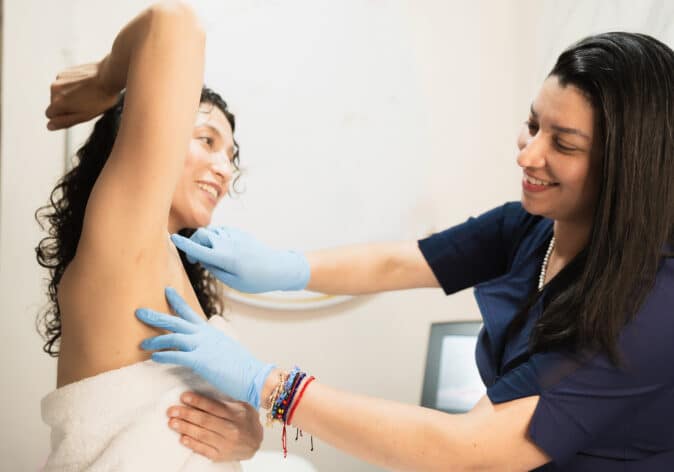What is triple-positive breast cancer?
Triple-positive breast cancer is a subtype of breast cancer that accounts for about 10% of all breast cancer diagnoses. It is characterised by the presence of three key protein receptors on or within the cancer cells:
- Oestrogen receptor (ER)
- Progesterone receptor (PR)
- Human epidermal growth factor receptor (HER2)
These receptors play a significant role in the growth and behaviour of this subtype of breast cancer. When these proteins are present, the tumour cells may be more sensitive to certain types of treatment.
Characteristics of triple-positive breast cancer receptors
- Oestrogen receptor (ER) positive: The oestrogen receptor is a protein found on certain breast cancer cells. When oestrogen, a hormone, attaches to this receptor, it signals the cancer cell to grow.
- Progesterone receptor (PR) positive: The progesterone receptor is another protein found on certain breast cancer cells. The progesterone receptor works with the oestrogen receptor to fuel cancer cell growth.
- HER2-positive: HER2-positive means the cancer cells have an abnormally high number of HER2 genes, resulting in an overproduction of the HER2 protein on the surface of the cell. This also fuels cancer cell growth.
How it differs from other types of breast cancer
Triple-positive breast cancer is a subtype that has all three key receptors: oestrogen receptors (ER), progesterone receptors (PR), and the HER2 receptors. These proteins can be targeted with treatments to help stop the growth and division of these breast cancer cells. On the other hand, triple-negative breast cancer lacks all three proteins, making it harder to treat.
Additionally, HER2-negative breast cancers do not overexpress the HER2 gene or receptor.
Triple-positive breast cancer treatment
Treatment for triple-positive breast cancer is often a multi-pronged approach, incorporating several types of therapy. These treatments are designed to target the specific receptors and characteristics of the breast cancer, offering the best chance for a favourable outcome.
Standard treatment options
Because triple-positive breast cancer has all three proteins, it can be treated effectively with a range of therapies, including:
- Hormone therapy: Medications such as tamoxifen or aromatase inhibitors are used to block the action of oestrogen or lower its levels in the body.
- HER2-targeted therapy: Drugs like trastuzumab (Herceptin) and pertuzumab (Perjeta) specifically target the HER2 receptor, stopping the breast cancer cells from growing.
- Chemotherapy: Chemotherapy may be used for tumours to reduce the risk of the cancer returning and spreading, or when targeted treatments may not be sufficient.
- Surgery and radiation therapy: For localised breast cancer, surgery to remove the tumour or affected tissue is a common treatment, often followed by radiation to eliminate and potential breast cancer cells that may remain.
Breast Cancer Trials has made significant contributions to improved treatments for breast cancer, including:
- Trastuzumab (Herceptin) – the HERA clinical trial
- Tamoxifen – the IBIS-I clinical trial
- Aromatase Inhibitors – the BIG 1-98 clinical trial
Personalised treatment plans
Every individual’s treatment plan is tailored to their specific diagnosis, which can vary based on the breast cancer’s molecular makeup, breast cancer stage, and overall health of the individual. Personalising treatment ensures the most effective therapies are chosen to manage the disease.
New treatments for triple-positive breast cancer
Research into new treatment options for triple-positive breast cancer is ongoing, with developments in targeted therapies and immunotherapy. These innovations are aimed at making treatments even more effective while reducing side effects.
A study has identified four distinct subtypes of triple-positive breast cancer, each with unique characteristics and potential treatment options. For some patients, combining multiple HER2-targeting drugs works best, while others may benefit from treatments that block both estrogen and HER2, along with additional targeted therapies.
One subtype could respond well to immune-boosting treatments, while another might require drugs that target specific cell pathways within cancer cells.
By continuing to improve the way in which we classify breast cancers on an individual basis, there is increased hope for more tailored, effective treatments to be delivered, improving outcomes for patients with this type of breast cancer.
Learn more about our recent research results:
- The PATINA clinical trial – This trial explored the benefit of Palbociclib in combination with HER2 targeting agents Trastuzumab and Pertuzumab as well as endocrine therapy in triple-positive breast cancer.
- The DIAmOND clinical trial – This trial tests if adding two immunotherapy drugs to Herceptin improves outcomes for people with HER2-positive metastatic breast cancer.
- The TUGETHER clinical trial – This trial explores using tucatinib and pembrolizumab to treat advanced HER2-positive breast cancer that has returned or spread after previous treatments.
Triple-positive breast cancer prognosis
The prognosis for triple-positive breast cancer can be influenced by a range of factors, including age, tumour stage, and how well the breast cancer responds to treatment. Generally, triple-positive breast cancers tend to have a more favourable prognosis compared to other breast cancer types, due to their sensitivity to targeted treatments.
Factors influencing survival outcomes
- Age: Younger women may face different challenges than older women due to factors like hormone sensitivity and how the body responds to treatments including side effects.
- Stage of cancer: Increasing cancer stages indicate more advanced disease. Cancer staging is based on both the nature of the primary tumour and the locations of spread, including to nearby lymph glands. While higher stage cancers are more challenging to treat, advances in therapies have greatly improved outcomes.
- Response to treatment: Triple-positive breast cancer can respond well to targeted treatments like hormone therapy and HER2-targeted therapy. They may also respond well to non-targeted treatment such as chemotherapy. For example, hormone therapy blocks oestrogen or progesterone, HER2-targeted therapy focuses on the HER2 protein, and chemotherapy works by killing rapidly dividing cells. When the cancer responds effectively to these therapies, the prognosis is usually more favourable.
Advancements in survival rates
Ongoing research is helping improve survival outcomes, with some patients being cured of their cancer thanks to advancements in targeted treatments and personalised care.
According to the Australian Institute of Health and Welfare, the five-year survival rate for stage 1 (early) breast cancer is on average 100%, while stage 2 is 95%. For locally advanced breast cancer (known as stage 3 triple-positive breast cancer), the five-year survival rate is 81% and the five-year survival rate for stage 4 or metastatic breast cancer is 32%.
Patients with triple-positive breast cancer who respond well to treatment, have excellent five-year survival rates.
Triple-positive breast cancer recurrence rate and long-term outlook
The recurrence rate of triple-positive breast cancer depends on factors such as treatment response and breast cancer stage.
Long-term follow-up and monitoring are crucial for detecting early signs of recurrence, ensuring timely intervention.
Triple-positive breast cancer survival rate
With targeted therapies, the prognosis for triple-positive breast cancer is generally favourable, though it depends on many factors. An excellent four-year survival rate is achievable for patients with triple-positive breast cancer who respond well to treatment.
According to a study by Naida Howlader, the highest survival rate was observed in women with the HR+/HER2− subtype, with a 92.5% survival rate at four years. This was followed by HR+/HER2+ at 90.3%, and HR−/HER2+ at 82.7%.
Recurrence rate and long-term outlook
Effective treatment reduces the rate of recurrence for triple-positive breast cancer. For many, the first five years post-treatment are critical for long-term survival and those in remission during this time often have a positive outlook.
Factors influencing recurrence
- Response to targeted therapy: Patients who receive effective targeted therapies are less likely to experience recurrence.
- Ongoing monitoring: Long-term follow-up is essential to detect any early signs of recurrence, ensuring timely intervention.
Emerging and new treatments
In the field of breast cancer research, continuous advancements in targeted therapies and immunotherapy have shown great promise for treating many cancers. Notably, combination treatments and new HER2-directed therapies as being developed.
There are also HER2-directed antibody-drug conjugates that aim to deliver a chemotherapy or radioisotope payload towards a HER2 expressing cell, offering more personalised and effective options for patients.
Staying informed
For the latest information on new treatments for triple-positive breast cancer, you can refer to reputable sources such as Cancer Australia. This platform provides updates on research, clinical trials, and new therapies.
Latest advancements
Emerging therapies focus on improving the precision of treatments and medicine, while ensuring the treatment plan is tailored to personalised needs. These advancements include:
- Immunotherapies and the Panacea Clinical Trial
- Trends in surgery de-escalation
- Surgical techniques
- Hormone therapy
- Targeted therapies.
Breast Cancer Trials’ Role in advancing research
Breast Cancer Trials plays an important role in leading research and testing innovative trials for breast cancer. Their commitment to advancing clinical trials ensures that patients have access to the latest therapies, providing them with hope and improved outcomes.
Genetic and hereditary factors
Genetic factors can influence a person’s risk of developing triple-positive breast cancer. Testing for mutations like BRCA1 and BRCA2 gene mutations can help assess the risk and provide information on personalised prevention strategies.
The role of genetic testing
Genetic testing can guide treatment decisions and risk assessment, especially for patients with a family history of breast cancer. Genetic counselling can help individuals understand their test results and the implications for their health and family.
Support Breast Cancer Trials
Breast Cancer Trials is a leader in advancing breast cancer research by funding crucial clinical trials aimed at testing new treatments and improving patient outcomes. Through this research, Breast Cancer Trials is helping to shape future treatments for triple-positive breast cancer and other subtypes, providing valuable insights that drive progress in the field.
Breast Cancer Trials also offers opportunities for patients to support or participate in this research. Whether you choose to donate or take part in a trial, your involvement helps move research forward so no more lives are cut short by breast cancer.
References:
- Nature: Molecular classification of hormone receptor-positive /HER2-positive breast cancer reveals potential neoadjuvant therapeutic strategies (https://www.nature.com/articles/s41392-025-02181-3)
- MD Anderson Center: What is triple-positive breast cancer? 6 insights (https://www.mdanderson.org/cancerwise/what-is-triple-positive-breast-cancer–6-insights.h00-159622590.html)
- American Assosicaton for Cancer Research: Differences in Breast Cancer Survival by Molecular Subtypes in the United States (https://aacrjournals.org/cebp/article/27/6/619/71580/Differences-in-Breast-Cancer-Survival-by-Molecular)
- Cancer Australia: Diagnosis of early breast cancer (https://www.canceraustralia.gov.au/cancer-types/breast-cancer/how-breast-cancer-diagnosed/diagnosis-early-breast-cancer)
Support Us
Help us to change lives through breast cancer clinical trials research



